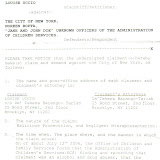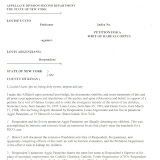Monday, July 28, 2008
BY MIKE McCORMICK AND GLENN SACKS
Women's advocates in New Jersey fear that a Superior Court judge's ruling in Hudson County will make it harder for women throughout the state to get restraining orders against their male partners.
Certainly abused women need protection and support, but there are many troubling aspects of the Domestic Violence Prevention Act's restraining order provisions that merit judicial or legislative redress
Under the law, it is very easy for a woman to allege domestic violence and get a restraining order (aka "protection order"). New Jersey issues 30,000 restraining orders annually, and men are targeted in four-fifths of them. The standard is "preponderance of the evidence" (often 51 percent to 49 percent), and judges almost always side with the accusing plaintiff.
Under the law, the accuser need not even claim abuse. Alleged ver bal threats of violence are suffi cient, even though it's almost impossible for the accused to provide substantive contradictory evi dence.
The restraining order boots the man out of his own home and generally prohibits him from contact ing his children. Men are cut off from their possessions and property, and some end up in homeless shelters. Yet most have never had a chance to defend themselves in court.
In recognition of the gravity of these orders, the Hudson County judge, Francis Schultz, found the standard of proof unconstitutional and required the stricter "clear and convincing evidence" standard in the case before him. His ruling was not binding on other judges but will likely be appealed, which could lead to a decision with a broader impact.
A large body of evidence shows that restraining orders are frequently misused. For example,the Family Law News, the official publication of the California Bar Association's family law sec tion, recently said:
"Protective orders are increasingly being used in family law cases to help one side jockey for an advantage in child custody ... (they are) almost routinely issued by the court in family law proceedings even when there is relatively meager evidence and usually without notice to the restrained person. ... it is troubling that they appear to be sought more and more frequently for retaliation and litigation purposes."
An article in the November 2007 issue of the Illinois Bar Journal said: "If a parent is willing to abuse the system, it is unlikely the trial court could discover (his or her) improper motives in an order of protection hearing."
These orders have become so commonplace that the Illinois Bar Journal called them "part of the gamesmanship of divorce."
Newark family law attorney Bruce Pitman says, "Anybody who practices family law sees people who abuse the restraining order process. Some create false allegations or take minor or insignificant acts and use them to remove their spouse or partner from the home for advantage in litigation. Such abuses undermine victims of real abuse and violence who seek protection."
Opponents of the ruling point to the relatively rare instances in which men have killed their female partners as evidence for why the law should stand. While these cases are heart-wrenching, they do not constitute a viable argu ment against the ruling. For one, the ruling does not eliminate restraining orders but merely re quires a proper evidence standard for their issuance.
Moreover, it is highly questionable whether restraining orders protect abused women. A violent spouse intent on killing his ex is not going to be deterred from doing so out of fear of violat ing a restraining order. In many domestic violence killings, a restraining order was already in place. In general, a restraining order is enforceable only against a law-abiding, nonviolent man.
Jane Hanson, executive direc tor of Partners for Women and Justice in Montclair, argues that Schultz is wrong in ruling that the Domestic Violence Prevention Act violates parents' "fundamental" right to "be with or maintain their relationship with their children." Yet when a restraining order is issued, fathers can be (and sometimes are) ar rested for calling their children on the phone or going to their Little League games.
Moreover, by removing the father from the home, a custody precedent is set with mom as primary caregiver and dad as occasional visitor -- a precedent that harms fathers' ability to gain joint custody of their children in di vorce proceedings.
Wood calls the law on restraining orders "an efficient system." We disagree. Yes, the system is efficient in separating men from their children and their homes. However, it is hardly efficient in delivering justice.
Mike McCormick is the executive director of the American Coalition for Fathers and Children. Glenn Sacks writes frequently about issues affecting men and fathers.
Link to Original Article --- Restraining orders can be straitjackets on justice - NJ.com
Subscribe to:
Post Comments (Atom)























No comments:
Post a Comment